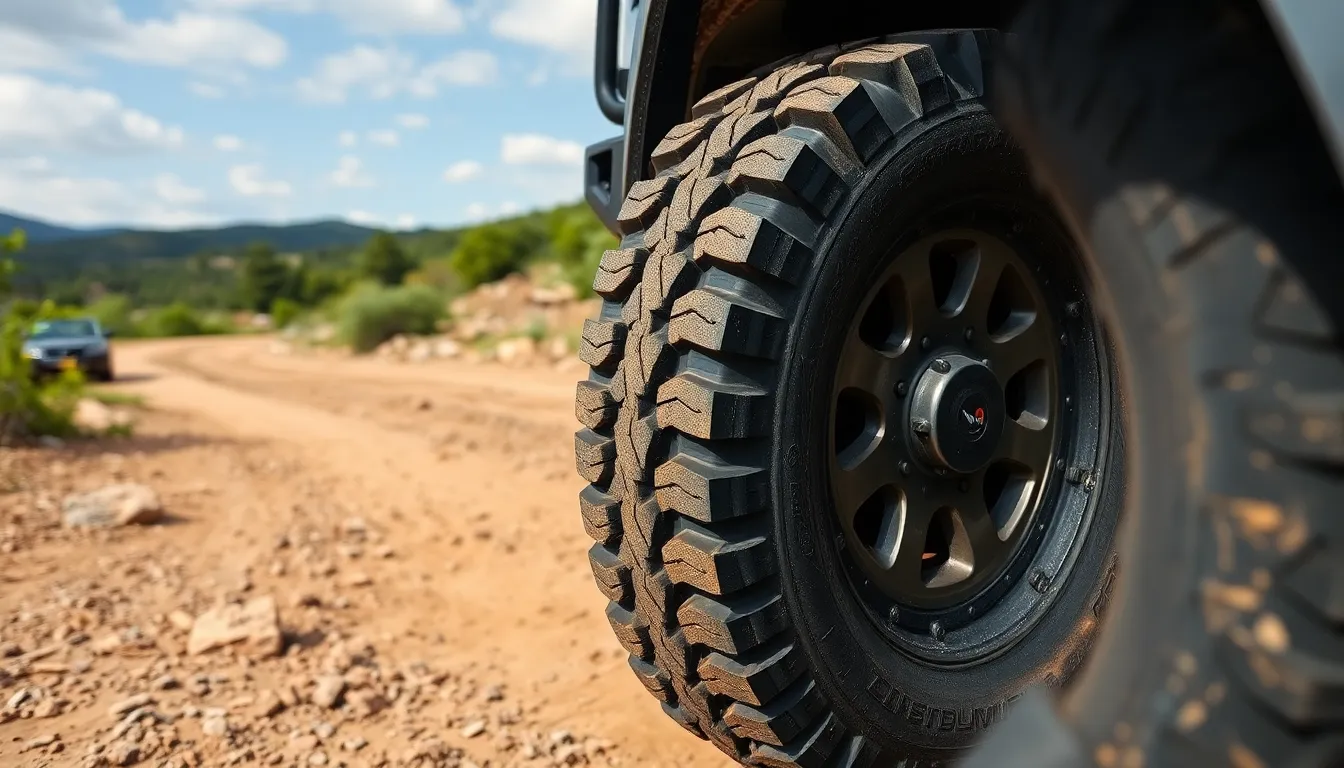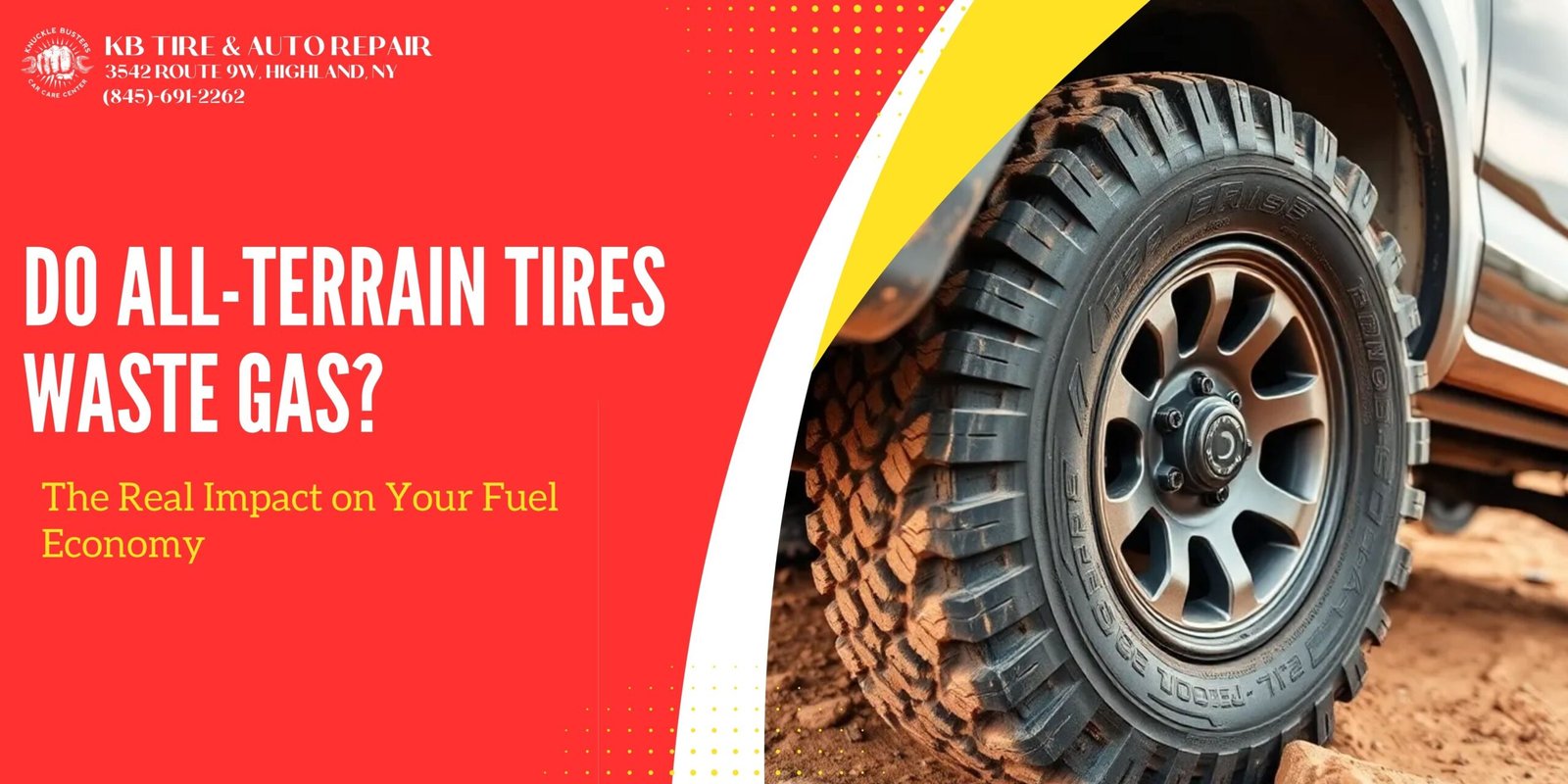Are you feeling that pinch at the pump lately? If you’ve upgraded to those rugged all-terrain tires for weekend adventures, you might be wondering if they’re quietly draining your wallet during weekday commutes.
You’re not alone in questioning whether those aggressive treads and tougher sidewalls are secretly sipping more fuel. Many drivers face this dilemma—balancing the desire for off-road capability with everyday fuel efficiency. It’s a legitimate concern, especially when gas prices climb and every mile per gallon counts.
Let’s cut through the noise and explore what really happens to your fuel economy when you switch to all-terrain tires, so you’ll know exactly what trade-offs you’re making for that extra traction and durability.
Understanding All-Terrain Tires and Fuel Economy
All-terrain tires affect your vehicle’s fuel economy due to their unique design characteristics. These rugged tires feature aggressive tread patterns, thicker sidewalls, and heavier construction compared to standard highway tires.
The deeper treads and wider spacing between lugs increase rolling resistance as more tire surface contacts the road. This additional friction requires your engine to work harder, consuming 2-3% more fuel on average. The heavier weight of all-terrain tires (typically 3-5 pounds heavier per tire than highway tires) also contributes to decreased fuel efficiency.
When driving on paved roads, all-terrain tires create more road noise and vibration due to their chunky tread blocks. This noise isn’t just an inconvenience—it’s audible evidence of energy being wasted that could otherwise contribute to forward motion. Each bump and vibration represents fuel consumption that isn’t efficiently converting to mileage.
For example, a vehicle that normally gets 25 MPG with standard highway tires might drop to 24 MPG or lower with all-terrain tires installed. This difference becomes more noticeable during long highway drives at consistent speeds where aerodynamics and rolling resistance play larger roles in fuel consumption.
The impact varies based on several factors: your specific tire model, driving habits, vehicle type, and road conditions. Some newer all-terrain tire models incorporate fuel-saving technologies that help mitigate these effects, making the fuel economy gap smaller than with older designs.
How All-Terrain Tires Affect Gas Mileage

All-terrain tires impact your vehicle’s gas mileage through several key mechanisms. These specialized tires are designed with specific features that, while beneficial for off-road performance, create additional resistance and weight that your engine must overcome.
The Role of Tread Pattern and Depth
The aggressive tread pattern on all-terrain tires directly influences fuel consumption. Deep, widely-spaced lugs and blocks create more contact points with the road surface, increasing friction as you drive. These pronounced tread blocks also trap air between them, creating turbulence and drag that your engine must work against. A typical all-terrain tire has 2-3 times deeper tread depth than standard highway tires, with patterns designed to grip loose surfaces rather than roll efficiently on pavement. As these tires rotate, each tread block experiences a small amount of flexing and squirming, converting valuable engine energy into heat instead of forward motion. Many drivers report seeing their fuel economy drop by 1-3 MPG after switching to aggressive all-terrain tires from highway tires.
Rolling Resistance Explained
Rolling resistance represents the energy lost when your tires deform against the road surface. All-terrain tires waste more gas primarily because they exhibit higher rolling resistance than standard tires. This resistance occurs as the tire’s rubber compounds, sidewall construction, and tread blocks flex and recover with each rotation. The stiffer compounds and reinforced construction of all-terrain tires create approximately 10-15% more rolling resistance than highway tires. For every gallon of gas your vehicle burns, about 15-20% of that energy is already spent overcoming tire resistance – with all-terrain tires pushing toward the higher end of that range. Modern all-terrain tire manufacturers like BFGoodrich, Goodyear, and Michelin have developed specialized rubber compounds that attempt to balance grip capabilities with fuel efficiency, though these premium options come at a higher price point.
Real-World Fuel Consumption Data With AT Tires

Real-world tests and driver experiences provide concrete evidence of how all-terrain tires affect fuel economy. These measurements from actual usage scenarios offer more reliable insights than theoretical estimates alone, helping you make informed decisions about your tire choices.
Highway vs. Off-Road Performance
All-terrain tires show different fuel consumption patterns depending on where you drive them. On highways, AT tires typically reduce fuel efficiency by 1-3 MPG compared to standard highway tires. A 2021 Consumer Reports study found that vehicles equipped with popular all-terrain models like BFGoodrich K02s experienced a 5-7% drop in highway fuel economy. This difference becomes less noticeable during off-road driving, where the specialized tread design provides necessary traction that compensates for the additional fuel usage.
Truck owners report varied experiences based on driving conditions. For example, a Ford F-150 owner documented a decrease from 18.5 MPG to 17.1 MPG after switching from highway tires to Falken Wildpeak AT3s for primarily highway driving. Conversely, Jeep Wrangler owners who frequently tackle rough terrain note that the fuel economy difference between tire types becomes negligible on unpaved surfaces, where standard tires would struggle.
Average MPG Decrease Percentages
The fuel efficiency impact of all-terrain tires varies by vehicle type, tire model, and driving conditions. Here’s what the data shows:
| Vehicle Type | Average MPG Decrease | Percentage Change |
|---|---|---|
| Mid-size SUVs | 1.5-2.5 MPG | 5-8% |
| Full-size Trucks | 1-3 MPG | 6-10% |
| Crossovers | 2-3 MPG | 7-12% |
| Jeep Wranglers | 1-2 MPG | 5-7% |
Long-term testing by automotive publications shows consistent patterns. Motor Trend’s 10,000-mile test of pickup trucks with all-terrain tires revealed an average fuel economy decrease of 7.3% compared to the same vehicles with highway tires. Toyota Tacoma owners participating in a 6-month fuel tracking study organized by an off-road enthusiast forum reported an average decrease of 1.8 MPG (approximately 8.2%) after switching to all-terrain tires.
The most significant factors affecting these percentages include tire weight, tread depth, and sidewall construction. Heavier AT tires with deeper treads waste more gas—sometimes pushing the fuel economy decrease to 10-15% in extreme cases, particularly with mud-terrain variants. Modern AT tires with fuel-efficient compounds, like the Continental TerrainContact A/T, show smaller decreases of just 3-5% in controlled tests.
Factors That Determine Fuel Efficiency With AT Tires

All-terrain tires affect fuel efficiency differently depending on several key variables. Understanding these factors helps you make informed decisions about whether AT tires are worth the potential increase in gas consumption for your specific situation.
Tire Weight and Construction
Tire weight and construction directly influence how much gas your all-terrain tires consume. Heavier AT tires require more energy to rotate, with each additional pound requiring approximately 1-2% more fuel to maintain momentum. Most all-terrain tires weigh 3-7 pounds more per tire than standard highway tires, creating a total added weight of 12-28 pounds for your vehicle. The rubber compounds used in AT tires are typically denser and more durable, contributing to increased rolling resistance. Premium all-terrain tires like the BFGoodrich All-Terrain T/A KO2 incorporate silica-infused compounds that help reduce rolling resistance by 5-10% compared to older AT tire models, partially offsetting their weight disadvantage.
Vehicle Type and Driving Habits
Your vehicle type and driving habits significantly impact how much extra gas all-terrain tires consume. Heavier vehicles like full-size trucks experience less proportional impact from AT tires, with fuel economy typically decreasing by 6-10%, while lighter crossovers may see 7-12% reductions. Aggressive driving behaviors amplify the fuel economy penalty of all-terrain tires—rapid acceleration forces these tires to work harder, consuming up to 15% more fuel than gentle acceleration with the same tires. Highway speeds above 65 mph increase the aerodynamic drag created by aggressive tread patterns, reducing fuel efficiency by an additional 1-2 MPG. Drivers who maintain steady speeds and practice gentle acceleration techniques can minimize the fuel economy impact of AT tires by 30-40% compared to aggressive drivers using identical tires.
Ways to Minimize Fuel Waste With All-Terrain Tires

While all-terrain tires typically consume more fuel than standard highway tires, you can implement several strategies to minimize their impact on gas mileage. These practical approaches help maintain the off-road capabilities you need while reducing unnecessary fuel consumption during daily driving.
Proper Inflation and Maintenance
Proper tire inflation stands as the most effective way to improve fuel economy with all-terrain tires. Underinflated AT tires can increase fuel consumption by 3-5% due to greater rolling resistance and sidewall flexing. Check your tire pressure at least once monthly and always before long trips or off-road excursions. The recommended PSI for your specific all-terrain tires appears on the sidewall or in your vehicle’s doorjamb placard—follow these guidelines precisely rather than estimating.
Regular rotation every 5,000-7,000 miles ensures even tread wear across all four tires, preventing irregular wear patterns that increase rolling resistance. Balance your AT tires at each rotation to minimize vibration, which wastes energy and fuel. Alignment checks twice yearly help prevent unnecessary drag from wheels pulling in different directions, potentially saving 1-2% in fuel consumption.
Removing excess mud and debris after off-road adventures prevents the added weight from impacting your fuel economy. Just 5 pounds of caked-on mud per tire creates up to 20 pounds of additional weight for your engine to move, reducing efficiency.
Choosing Fuel-Efficient AT Tire Models
Not all all-terrain tires impact fuel economy equally. Modern fuel-efficient AT tire models incorporate advanced technologies to reduce rolling resistance while maintaining off-road capability. Tires like the Continental TerrainContact A/T and Michelin LTX A/T2 feature specialized silica compounds that reduce rolling resistance by up to 10% compared to traditional all-terrain designs.
Look for all-terrain tires with these fuel-saving features:
- Interlocking tread patterns that provide stability with less squirm
- Variable-depth sipes that offer traction without excessive rolling resistance
- Rounded shoulder designs that reduce drag during highway driving
- Optimized rubber compounds developed specifically for reduced fuel consumption
Consumer ratings and independent tests offer valuable insights into real-world fuel economy. The BFGoodrich All-Terrain T/A KO2, for example, shows only a 3-4% fuel economy penalty in many vehicles despite its aggressive tread pattern, thanks to its advanced construction. When shopping for replacement AT tires, compare EPA fuel economy ratings between models and consider “hybrid” all-terrain tires that bridge the gap between highway and off-road performance.
Many tire manufacturers now clearly label their more fuel-efficient options with “eco,” “fuel saver,” or similar designations. While these models typically cost 10-15% more initially, they often save more in fuel costs over their 40,000-60,000 mile lifespan, especially with current gas prices.
When All-Terrain Tires Make Sense Despite Fuel Costs

All-terrain tires justify their fuel economy penalty in specific scenarios where their benefits outweigh the additional gas consumption. Off-road enthusiasts regularly tackling challenging trails gain superior traction and durability that standard highway tires simply can’t match. The 2-3% increase in fuel consumption becomes negligible compared to the confidence and capability these tires provide in mud, rocks, and snow.
For Frequent Off-Road Adventures
All-terrain tires deliver exceptional value when you’re regularly exploring unpaved terrain. If you’re spending weekends navigating forest service roads or desert trails, the improved traction and puncture resistance save you from costly tow services and roadside repairs. The 1-3 MPG sacrifice translates to just $50-150 annually for most drivers—far less than a single towing bill from a remote location.
For Mixed Driving Conditions
You’ll appreciate all-terrain tires if you routinely encounter varying road surfaces. Construction workers accessing job sites, rural residents navigating gravel roads, or outdoor professionals dealing with snow-covered streets benefit from the versatility. The slightly higher fuel costs ($5-10 monthly for most vehicles) provide year-round reliability without switching between specialized seasonal tires.
For Safety in Adverse Weather
All-terrain tires excel in harsh weather conditions, particularly snow and heavy rain. Their deeper tread patterns and specialized siping create additional biting edges that maintain traction when standard tires slip. Drivers in regions with frequent snowfall or mountain terrain find the marginal increase in fuel consumption (approximately 5-8%) worth the enhanced safety margin and reduced accident risk.
For Long-Term Value Considerations
The durability advantage of all-terrain tires often compensates for their fuel efficiency penalty. Quality AT tires typically last 40,000-60,000 miles, compared to 30,000-50,000 for standard highway tires. This extended lifespan offsets higher fuel costs over time. For example, a truck getting 2 MPG less with AT tires might spend an extra $300 annually on fuel but save $200-400 on tire replacement costs when calculated over the tires’ lifetime.
For Aesthetic and Lifestyle Alignment
The distinctive appearance of all-terrain tires complements rugged vehicles and outdoor lifestyles. The aggressive sidewall designs and pronounced tread patterns enhance your vehicle’s visual appeal while signaling your adventure-ready mindset. For many outdoor enthusiasts, this aesthetic value combined with the practical benefits justifies the modest increase in fuel expenses.
Conclusion
All-terrain tires do consume more gas than standard highway tires but the fuel economy penalty isn’t as severe as you might fear. You’ll likely experience a 2-3% decrease in MPG due to increased weight and rolling resistance.
Your driving habits and vehicle type significantly influence how much extra fuel you’ll use. Keeping your tires properly inflated and driving smoothly can minimize this impact substantially.
For many drivers the tradeoff is worthwhile. The versatility safety and durability benefits often justify the modest increase in fuel costs especially if you regularly venture off pavement or drive in challenging conditions.
Modern AT tire technology continues to improve with newer models offering better fuel efficiency than their predecessors. Choose wisely and you can enjoy rugged performance without emptying your wallet at the pump.
Frequently Asked Questions
How much do all-terrain tires affect fuel economy?
All-terrain tires typically reduce fuel economy by 2-3% compared to standard highway tires. This translates to approximately 1-3 MPG less, depending on your vehicle. For example, a vehicle that normally gets 25 MPG might drop to around 24 MPG after switching to all-terrain tires. The impact varies based on the specific tire model, your driving habits, vehicle type, and road conditions.
Why do all-terrain tires decrease gas mileage?
All-terrain tires decrease gas mileage due to three main factors: increased rolling resistance from aggressive tread patterns, added weight (typically 3-5 pounds heavier per tire), and greater road friction. The deeper treads create air turbulence and drag, while the stiffer rubber compounds and reinforced construction increase the energy needed to move your vehicle. These design features that enhance off-road capability directly work against fuel efficiency.
Which vehicles experience the biggest fuel economy drop with AT tires?
Lighter vehicles like crossovers experience the most significant fuel economy drop with all-terrain tires, typically 7-12%. Mid-size SUVs see a 5-8% decrease, while full-size trucks experience a 6-10% reduction. Heavier vehicles feel less proportional impact because the additional rolling resistance represents a smaller percentage of their overall power needs. Vehicle aerodynamics and engine efficiency also influence the final impact.
Can driving habits reduce the fuel economy penalty of AT tires?
Yes! Smooth, consistent driving can reduce the fuel economy penalty by 30-40% compared to aggressive driving. Maintain steady speeds, practice gentle acceleration, and avoid rapid starts and stops. Cruise control on highways helps maintain optimal fuel efficiency. Also, reduce unnecessary idling and excess weight in your vehicle. These habits are even more important with all-terrain tires than with highway tires.
Is proper tire maintenance important for fuel economy with AT tires?
Absolutely. Proper tire inflation is crucial—underinflated tires can waste an additional 3-5% in fuel. Check pressure monthly and before long trips. Regular rotation every 5,000-7,000 miles ensures even wear and consistent performance. Alignment checks help prevent drag from misaligned wheels. These maintenance practices are especially important with all-terrain tires to minimize their inherent fuel economy disadvantages.
Are there fuel-efficient all-terrain tire options available?
Yes, many manufacturers now offer fuel-efficient all-terrain tires using advanced rubber compounds and tread designs. Look for models with silica-infused compounds that reduce rolling resistance by 5-10%. Tires like Continental TerrainContact A/T, Michelin LTX A/T2, and Bridgestone Dueler A/T Revo 3 offer better fuel economy than traditional all-terrain options. These premium options may cost more initially but can pay off through fuel savings.
When is the fuel economy trade-off worth it for all-terrain tires?
The fuel economy penalty is worth it if you regularly drive off-road, frequently travel on unpaved roads, encounter adverse weather conditions, or need versatility for mixed driving environments. The superior traction, durability, and puncture resistance can prevent costly repairs and provide safety benefits that outweigh the 2-3% increase in fuel consumption. Additionally, their typically longer tread life can offset higher fuel costs over time.
Do all-terrain tires perform differently in highway versus off-road driving?
Yes. On highways, all-terrain tires typically reduce fuel efficiency by 1-3 MPG compared to highway tires. However, in off-road conditions, they can actually improve efficiency compared to highway tires, which would struggle and spin more frequently. The specialized tread pattern that creates drag on pavement provides necessary grip on loose surfaces, making your vehicle work less hard when off-roading.
